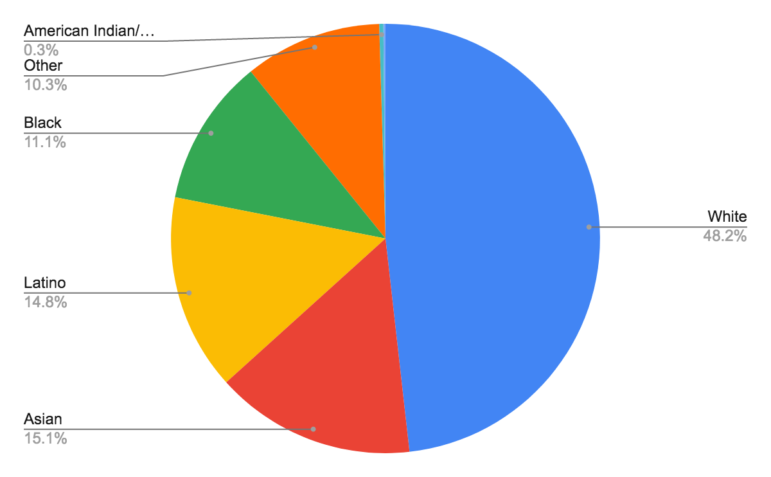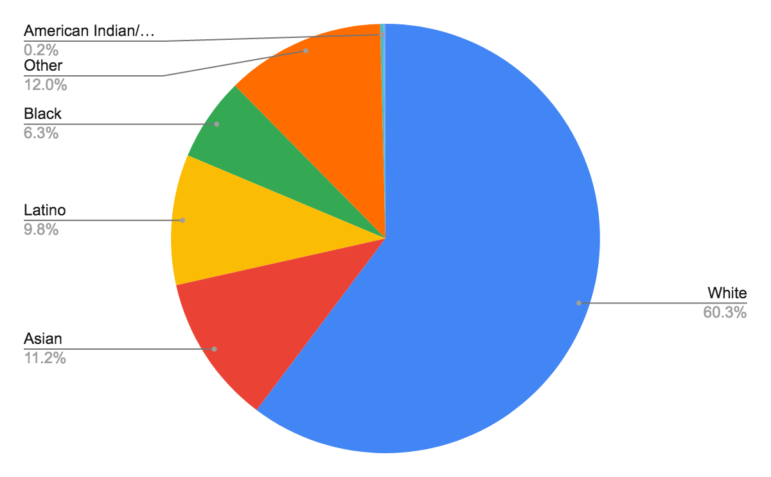Demographic data released by the city on Sunday reinforced concerns that the vaccine rollout effort has not done enough to reach the city’s communities of color ― Black and Latino New Yorkers in particular.

Adi Talwar
A person getting vaccinated at the South Bronx Educational Campus Vaccine Hubs located on St Ann’s Avenue.New York City released vaccination demographic data on Sunday, reinforcing concerns that the vaccine rollout effort has not done enough to reach the city’s communities of color ― Black and Latino New Yorkers in particular. The data also reveal that vaccination disparities by race are even more stark among non-NYC residents who’ve gotten vaccinated in the city, who account for more than a quarter of those inoculated here so far and are largely white.
Throughout the pandemic, Black and Latino New Yorkers have faced disproportionate levels of illness, death, and economic strife, and the newly released city data bolsters worries that vaccination sites in communities of color (such as the one at Washington Heights Armory) are not yet doing enough to serve them.
The city’s data show that 48 percent of people who live in and were vaccinated in New York City so far were white, 15 percent were Asian, 15 percent were Latino and 11 percent were Black. Of those who reside outside the city but got vaccinated here ― accounting for 28 percent of all adults who’ve received both doses ― 59 percent were white, 12 percent were Asian, 10 percent were Latino and 6 percent were Black.
The disparities in the data drew condemnation from some local leaders. City Council member Mark Levine, who chairs the Council’s Health Committee, wrote on Twitter that the stats reveal a “picture of profound inequality.”
“We need dramatic action NOW to fix this,” he said.


The information released Sunday also demonstrates the need for better vaccine data collection: the city does not have race/ethnicity demographic data for 40 percent of those who received their first vaccine dose, or 267,887 people. Although there are always some who decline to provide demographic information, Mayor Bill de Blasio and Health Commissioner Dave Chokshi called for more consistency around data collection among providers giving out the vaccine.
Chokshi said Monday that the city sent out a health alert to clinicians “making very explicit what our obligations are with respect to reporting on race and ethnicity as part of our immunization efforts.”
The city’s data also revealed that 25 percent of people who received their first dose of the COVID-19 vaccine live outside of New York City, and 28 percent of those who received both doses live outside of the city.
At a briefing on Monday, de Blasio noted that while the city’s vaccine rollout should include people who live outside the five boroughs and serve the city ― as healthcare workers or teachers, for example ― that shouldn’t apply to those who do not work here.
“This is where we need to work with the state on the solution,” he said. “Each of our suburban areas has gotten their own allotment and we really want to make sure that people who live in the suburbs to the maximum extent possible, live in other states to the maximum extent possible, get their vaccines where they live.”
He added that about 29,000 doses in the city’s allotment have been given to people who live in New Jersey and Connecticut, saying it’s “absolutely a fair and smart priority” for those who are public servants in the city, but he expects that some “are just individuals who came in because they had an opportunity to get a dose.”
So far, of the people the city has vaccinated with at least one dose for which demographic data is known, 214,420 were 65 years old or up. City Limits reported previously on how the limited vaccine supply has hindered its distribution to seniors, and has also limited the city’s flexibility for addressing inequity.
Mayor de Blasio reiterated on Monday that the city would be able to take more action right away to address disparities if it weren’t for the limited availability of doses.
“If we get a bigger supply, I think that’s the single biggest difference maker, because what that means is in communities all over the city, people start to know more and more people in their life who have gotten vaccinated,” he said. “That’s going to be the biggest impact, that word of mouth.”
Indeed, a recent poll of New York City residents aged 18 and older showed that 42 percent expressed hesitancy toward taking the vaccine. Yet, within the group that expressed hesitancy, 10 percent said they’d only take the vaccine after someone they know got vaccinated, while 14 percent said they’d only get vaccinated after many people they know receive the vaccine.
In the meantime, de Blasio says the city will work on getting the supply it does have “to the grassroots” or “the sites that people really know in their community” and to focus on better communication with New Yorkers in different languages.
So far, the city has not released data for who has gotten vaccinated broken down by neighborhood or borough.
On Sunday, he also announced that vaccine sites in 33 neighborhoods, identified by the city’s Taskforce on Racial Inclusion and Equity, will now prioritize appointments for residents, designating specific hours and slots. A list of those neighborhoods is below.
| Task Force Neighborhoods | Borough | ZIP Codes |
| Lower East Side and Chinatown | Manhattan | 10002, 10003, 10009, 10013 |
| Morningside Heights and Hamilton Heights | Manhattan | 10025, 10027 10031, 10032 |
| Central Harlem | Manhattan | 10026, 10027, 10030, 10037 10039 |
| East Harlem | Manhattan | 10029, 10035 |
| Washington Heights and Inwood | Manhattan | 10032, 10033, 10034, 10040 |
| Mott Haven and Melrose | Bronx | 10451, 10454, 10455, 10456 |
| Hunts Point and Longwood | Bronx | 10455, 10459, 10474 |
| Morrisania and Crotona | Bronx | 10456, 10459, 10460 |
| Highbridge and Concourse | Bronx | 10452 |
| Fordham and University Heights | Bronx | 10453, 10458 |
| Belmont and East Tremont | Bronx | 10457, 10458 |
| Kingsbridge | Bronx | 10463, 10468 |
| Parkchester and Soundview | Bronx | 10472, 10473 |
| Williamsbridge and Baychester, Edenwald | Bronx | 10466, 10467, 10468 |
| Bedford Stuyvesant | Brooklyn | 11205, 11206, 11216, 11221, 11233, 11238 |
| Bushwick | Brooklyn | 11206, 11207, 11221, 11237 |
| East New York and Starrett City | Brooklyn | 11207 11208, 11239 |
| Sunset Park | Brooklyn | 11220, 11232 |
| Coney Island | Brooklyn | 11224, 11235 |
| Flatbush and Midwood | Brooklyn | 11226 |
| Brownsville | Brooklyn | 11212, 11233 |
| East Flatbush | Brooklyn | 11203, 11226 |
| Flatlands and Canarsie | Brooklyn | 11236 |
| Queensbridge and Astoria | Queens | 11101 |
| Jackson Heights | Queens | 11368, 11369 |
| Elmhurst and Corona | Queens | 11368 |
| Briarwood, Flushing South | Queens | 11435 |
| Kew Gardens and Woodhaven | Queens | 11419, 11421 |
| Woodhaven, Richmond Hill, South Ozone Park | Queens | 11419, 11420 |
| Jamaica and Hollis | Queens | 11412, 11423, 11432, 11433, 11434, 11435, 11436 |
| Queens Village | Queens | 11429 |
| Rockaway and Broad Channel | Queens | 11691, 11692, 11693, 11694 |
| St. George, Stapleton, Port Richmond | Staten Island | 10301, 10303, 10304, 10310 |
Nicole Javorsky is a Report for America corps member.









4 thoughts on “Who’s Getting Vaccinated So Far in New York City?”
Thanks for continuing to report on this topic.
“On Sunday, [Mayor de Blasio] also announced that vaccine sites in 33 neighborhoods, identified by the city’s Taskforce on Racial Inclusion and Equity, will now prioritize appointments for residents, designating specific hours and slots.”
This is a profoundly Bad Idea. Making an appointment to receive a vaccine is already — as has been reported — challenging. Vaccination sites — as has been reported — heavily prioritize some neighborhoods over others, which IMHO is good.
What’s needed: NOT more hurdles and impediments. As you previously reported: some vaccination sites are being located in NYCHA complexes. Good! Embiggen this number.
What’s needed: more vaccination uptake. Maybe I’m slow, but I can’t get my mind around how being MORE SELECTIVE about who gets vaccination appointments gets us to more vaccinations.
Getting a slot to be vaccinated for either the City or State is challenging because of how the websites make you enter your personal data over and over again. This gives the edge to people who have devices and a reliable internet connection, plus the time and ability to keep trying over and over again, or who have friends or relatives who do. This set of people skews white.
Add to this the vaccine hesitancy (justified or otherwise) among people of color, due to both historical experience and current treatment by the medical profession.
Take the two together, and this likely explains the differences.
Just a note on two zip codes. 1)The zip code for Kew Gardens is 11415. 2) The zip code for Elmhurst is 11373.
YK – Trying to get an appt is impossible. So by adding another age group will only make it worse. I notice that for my residence in Qns there isn’t even a zip code and the one there is for Corona. What about the seniors with health conditions. We now have to wait until all the other people get it. We’ll have to wait forever. Only can you get an appt (maybe) if you know someone working in healthcare.